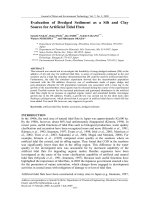Fit a bath and wash basin
Bạn đang xem bản rút gọn của tài liệu. Xem và tải ngay bản đầy đủ của tài liệu tại đây (155.99 KB, 6 trang )
FIT A BATH AND WASH
BASIN
A good knowledge of plumbing techniques and some
understanding of building construction would be an
advantage.
Be careful not to strain yourself whilst manoeuvring the
appliances. Ensure that all metal pipes and fittings are cross-
bonded with 6mm squared sheathed earthing wire.
Protective goggles, gloves and ear defenders may be needed
for some operations.
Changing your bath and washbasin gives you the ideal
opportunity to re-style your whole bathroom.
Plan your new installation thoroughly. If you only have one
bathroom in the house, the work must be carried out
efficiently to minimise the time that the amenities are
unavailable. If you have any concerns, ask professionals to
carry out the work. The methods described here refer to the
separate removal and installation of each fitting. However, in
practice it is more convenient to strip out the room first,
then carry out the new installation.
2
- Preparing the room
Clear the room of all storage units and fixtures, such as
towel rails and blinds. If the bath has a shower screen,
remove it. Take up carpeting, but leave sheet vinyl in place
until all the fittings have been removed. If you plan to install
new lighting or an extractor fan, make the alterations at this
stage.
The bath and basin are connected to the plumbing by water-
supply pipes and wastepipes. These pipes must be
disconnected before the fittings can be removed. First shut
off the hot and cold supply.
If your house has old lead pipes, make the most of this
opportunity and ask a plumber to replace them with copper
or plastic plumbing.
3
- Removing the old bath
Remove the bath panels to reveal the plumbing. Open the
taps to drain them, then disconnect the supply pipes. Place a
shallow bowl under the bath trap to catch the water, then
disconnect the wastepipe.
If the connectors cannot be unscrewed, saw through the
pipes. Also, cut through the old bath overflow.
If the bath has been sealed against the wall with flexible
sealant, cut through this with a craft knife. Pull the bath out
from the walls. If the bath has adjustable feet, it may help
to lower these first.
Unless a heavy cast-iron bath is worth salvaging, it is easier
to move it by first breaking it up into manageable pieces.
Cover the bath with an old blanket and strike it with a club
hammer. Protective goggles, gloves and ear defenders
should be worn during this operation.
Once the bath has been removed, extract the old overflow
pipe from the wall and repair the hole with mortar and
plaster. Also, remove old wall tiles and prepare the walls for
retiling.
When applying new wall tiles, measure out and cut a groove
in the plaster to inset the rim of the bath. This ensures a
good waterproof joint.
4
- Fitting the new bath
Before fixing a new bath or its panels, remove the protective
covering and check thoroughly for damage or colour faults. Any
claims made after the bath is fitted will not be accepted by the
manufacturer.
To add stiffness, most moulded plastic baths have a baseboard
bonded underneath and a wooden frame bonded beneath the
rim. A cradle kit is usually supplied for self assembly. Following
the manufacturer's instructions, fit the cradle legs to the frame
and baseboard. Also fit the centre support leg, if supplied (1).
Attach the wall-fixing brackets to the underside of the rim-
support frame. Fit hand grip(s) to the rim if supplied.
Set the bath upright and fit individual hot and cold taps or a
mixer-tap set. Attach flexible connecting pipes to the tap tails -
this allows for any misalignment when you connect up with the
supply pipes.
Fit the overflow outlet and waste
outlet into the bath. Connect
them with a combined waste-
and-overflow unit that
incorporates a deep-seal trap
(2).
Place the bath in the required position and adjust the screw feet
to set the height and level of the rim so that it can
accommodate the side panels.
When everything is in place, screw the brackets to the wall and
the feet to the floor. Connect the supply and wastepipes (see
below).
Fit the bath panels according to
the manufacturer's instructions
(3). Use a fine-toothed saw to
shape the panels around pipes o
to fit the skirting.
r
If you are constructing your own bath panel, make it easy to
remove, so that it provides simple access to plumbing and some
useful long-term storage.
Once the walls have been tiled
(4), waterproof the joint around
the rim of the bath with silicone
sealant.
After using an acrylic bath, clean it while it is still warm, using
soapy water. Then wipe it dry. Do not use organic solvents or
abrasive cleaners.
5 - Fitting a pedestal wash basin
Disconnect the supply pipes from the old taps, using a
cranked spanner to reach behind the basin. If this proves
difficult, cut the pipes at a convenient level for connecting
with the new flexible tap connectors.
Unscrew the old basin fixings and lift clear. Remove
supporting brackets from the wall or unscrew the pedestal
base from the floor.
Place the new basin on its pedestal base and position it
against the wall. Mark the fixing points on the wall and floor.
Drill and fit wall plugs on the
marks (5). Just drill pilot
holes for the screws when
fixing to a wooden floor.
Make any alterations to the 15mm (1/2in) supply pipes so
they will be neatly concealed by the pedestal. Fit miniature
in-line isolating valves for future servicing.
Fit new taps and a waste outlet in the basin. Check that the
tap spouts are correctly aligned. Do not over-tighten the
back nuts. Fit flexible connection pipes to the tap tails. Then
fit a 32mm (1.25in) waste trap to the waste outlet.
When fitting taps to a rim made from a thin material (such
as pressed steel), use a 'top-hat' spacer fitting placed under
the back nut (6).
Place the basin on its
pedestal and fix it in place
with brass screws. Connect
the trap to the existing 3
(1.25in) wastepipe. If a new
waste pipe is required in a
different position, drill a
clearance hole through the
wall with a masonry core
drill, and install a new pipe
run (see next section).
2mm
Connect the flexible tap connectors to the appropriate hot
and cold supplies. Follow the manufacturer's instructions, as
some taps require check valves to be fitted. Turn on the
water supply to test the installation.
Unless you are experienced with electrical installations, ask
an electrician to fit supplementary bonding to all metal
fittings and pipework.
6
- Supply pipes and wastepipes
Baths are fitted with 22mm (3/4in) taps and supply pipes;
basins with 12mm (1/2in) taps and pipes. Monobloc mixer
taps usually have 10mm (3/8in) tails, and a reducer is
needed when connecting them to standard pipework.
You can use copper supply pipes, connected with soldered or
compression joints, or plastic pipes that are usually
connected with push-fit joints. Adapter couplings are
available to join pipes of different materials and sizes.
Always follow tap manufacturers' instructions when
connecting supply pipes, as some tap installations require
check valves to be fitted.
Plastic pipe is used for wastes: 40mm (1.5in) pipe for baths;
32mm (1.25in) for washbasins; and 21mm (3/4in) for
overflows. Solvent-welded joints, push-fit connectors or
compression joints are used to join plastic wastepipes.
Unless you are connecting to
existing wastepipes, new
bath and basin wastes sh
be connected to a soil-stac
with boss fittings (7).
ould
k
g-
If a trap cannot be removed
to provide access to the
wastepipe, include a roddin
eye fitting so that any
blockages can be cleared (8).









